Jayjun Lee
AimBot: A Simple Auxiliary Visual Cue to Enhance Spatial Awareness of Visuomotor Policies
Aug 11, 2025Abstract:In this paper, we propose AimBot, a lightweight visual augmentation technique that provides explicit spatial cues to improve visuomotor policy learning in robotic manipulation. AimBot overlays shooting lines and scope reticles onto multi-view RGB images, offering auxiliary visual guidance that encodes the end-effector's state. The overlays are computed from depth images, camera extrinsics, and the current end-effector pose, explicitly conveying spatial relationships between the gripper and objects in the scene. AimBot incurs minimal computational overhead (less than 1 ms) and requires no changes to model architectures, as it simply replaces original RGB images with augmented counterparts. Despite its simplicity, our results show that AimBot consistently improves the performance of various visuomotor policies in both simulation and real-world settings, highlighting the benefits of spatially grounded visual feedback.
ViTaSCOPE: Visuo-tactile Implicit Representation for In-hand Pose and Extrinsic Contact Estimation
Jun 13, 2025Abstract:Mastering dexterous, contact-rich object manipulation demands precise estimation of both in-hand object poses and external contact locations$\unicode{x2013}$tasks particularly challenging due to partial and noisy observations. We present ViTaSCOPE: Visuo-Tactile Simultaneous Contact and Object Pose Estimation, an object-centric neural implicit representation that fuses vision and high-resolution tactile feedback. By representing objects as signed distance fields and distributed tactile feedback as neural shear fields, ViTaSCOPE accurately localizes objects and registers extrinsic contacts onto their 3D geometry as contact fields. Our method enables seamless reasoning over complementary visuo-tactile cues by leveraging simulation for scalable training and zero-shot transfers to the real-world by bridging the sim-to-real gap. We evaluate our method through comprehensive simulated and real-world experiments, demonstrating its capabilities in dexterous manipulation scenarios.
Neural Inverse Source Problems
Nov 03, 2024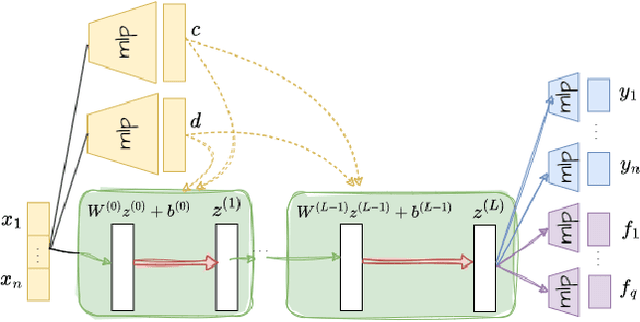

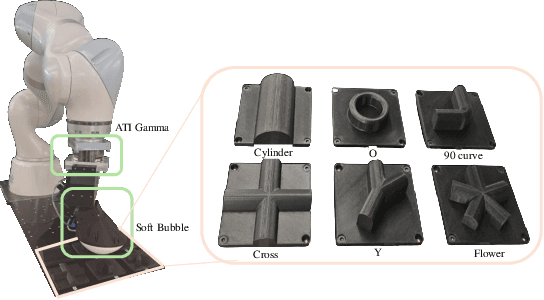

Abstract:Reconstructing unknown external source functions is an important perception capability for a large range of robotics domains including manipulation, aerial, and underwater robotics. In this work, we propose a Physics-Informed Neural Network (PINN [1]) based approach for solving the inverse source problems in robotics, jointly identifying unknown source functions and the complete state of a system given partial and noisy observations. Our approach demonstrates several advantages over prior works (Finite Element Methods (FEM) and data-driven approaches): it offers flexibility in integrating diverse constraints and boundary conditions; eliminates the need for complex discretizations (e.g., meshing); easily accommodates gradients from real measurements; and does not limit performance based on the diversity and quality of training data. We validate our method across three simulation and real-world scenarios involving up to 4th order partial differential equations (PDEs), constraints such as Signorini and Dirichlet, and various regression losses including Chamfer distance and L2 norm.
Do Vision-Language Models Represent Space and How? Evaluating Spatial Frame of Reference Under Ambiguities
Oct 22, 2024Abstract:Spatial expressions in situated communication can be ambiguous, as their meanings vary depending on the frames of reference (FoR) adopted by speakers and listeners. While spatial language understanding and reasoning by vision-language models (VLMs) have gained increasing attention, potential ambiguities in these models are still under-explored. To address this issue, we present the COnsistent Multilingual Frame Of Reference Test (COMFORT), an evaluation protocol to systematically assess the spatial reasoning capabilities of VLMs. We evaluate nine state-of-the-art VLMs using COMFORT. Despite showing some alignment with English conventions in resolving ambiguities, our experiments reveal significant shortcomings of VLMs: notably, the models (1) exhibit poor robustness and consistency, (2) lack the flexibility to accommodate multiple FoRs, and (3) fail to adhere to language-specific or culture-specific conventions in cross-lingual tests, as English tends to dominate other languages. With a growing effort to align vision-language models with human cognitive intuitions, we call for more attention to the ambiguous nature and cross-cultural diversity of spatial reasoning.
Visual-auditory Extrinsic Contact Estimation
Sep 22, 2024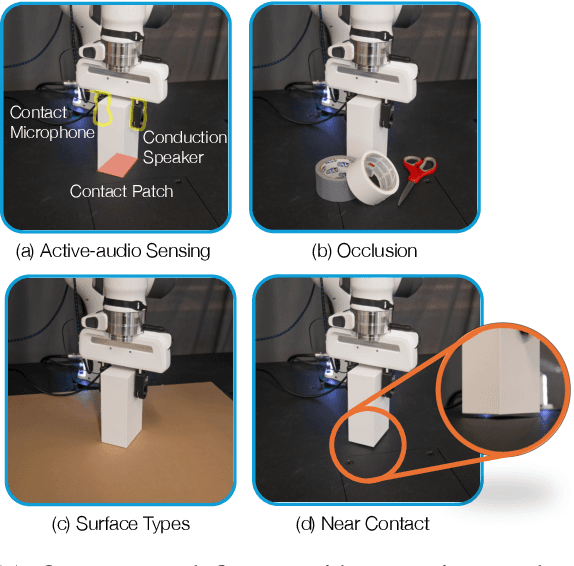
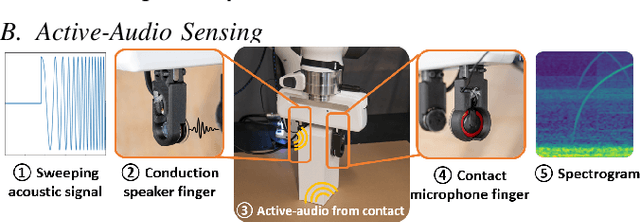
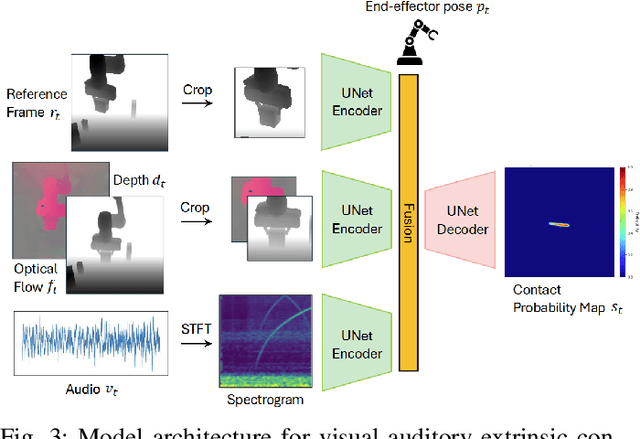

Abstract:Estimating contact locations between a grasped object and the environment is important for robust manipulation. In this paper, we present a visual-auditory method for extrinsic contact estimation, featuring a real-to-sim approach for auditory signals. Our method equips a robotic manipulator with contact microphones and speakers on its fingers, along with an externally mounted static camera providing a visual feed of the scene. As the robot manipulates objects, it detects contact events with surrounding surfaces using auditory feedback from the fingertips and visual feedback from the camera. A key feature of our approach is the transfer of auditory feedback into a simulated environment, where we learn a multimodal representation that is then applied to real world scenes without additional training. This zero-shot transfer is accurate and robust in estimating contact location and size, as demonstrated in our simulated and real world experiments in various cluttered environments.
Naturalistic Robot Arm Trajectory Generation via Representation Learning
Sep 14, 2023


Abstract:The integration of manipulator robots in household environments suggests a need for more predictable and human-like robot motion. This holds especially true for wheelchair-mounted assistive robots that can support the independence of people with paralysis. One method of generating naturalistic motion trajectories is via the imitation of human demonstrators. This paper explores a self-supervised imitation learning method using an autoregressive spatio-temporal graph neural network for an assistive drinking task. We address learning from diverse human motion trajectory data that were captured via wearable IMU sensors on a human arm as the action-free task demonstrations. Observed arm motion data from several participants is used to generate natural and functional drinking motion trajectories for a UR5e robot arm.
* 4 pages, 3 figures
 Add to Chrome
Add to Chrome Add to Firefox
Add to Firefox Add to Edge
Add to Edge